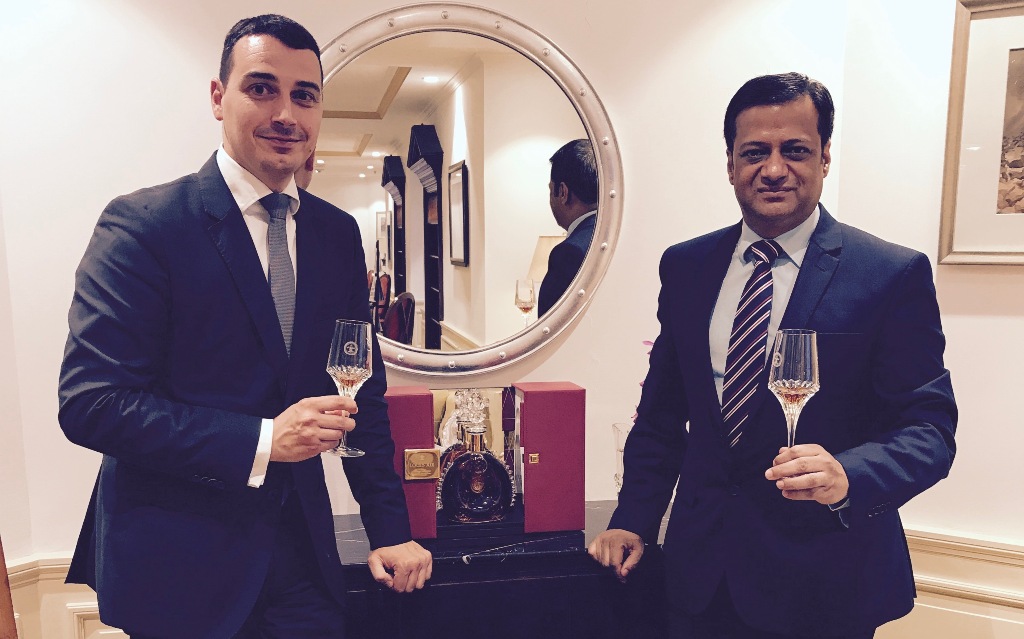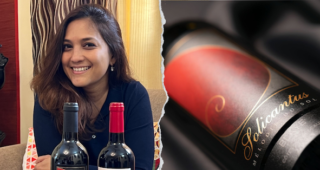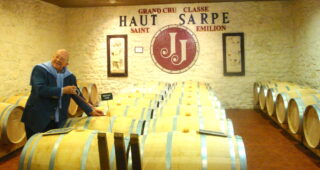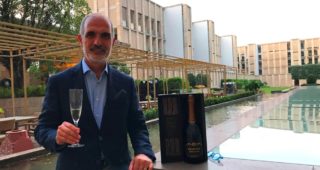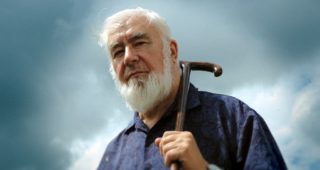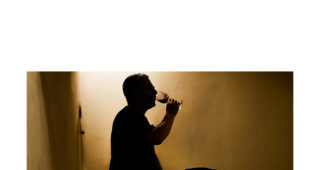It is not often that cellar masters come to your doorstep, that too with their most prized libations. Add to that, the charm of a centuries old historical perspective and you’re in for a dream. I am talking of Baptiste Loiseau, Maître de Chai or Cellar Master of the famed house of Rémy Martin (RM) – who came visiting India quite recently and whom I had the privilege to meet, also to taste with him the famed Louis XIII (popularly called Louis Treize) – their ultra premium cognac offering.

That Baptiste is the youngest ever Cellar Master of RM is interesting to know, but what is more interesting is his association with the roots of Cognac ever since his childhood. He was born and raised in the region, just a few miles from the house of LOUIS XIII, making him a natural enough to describe LOUIS XIII as evoking memories of his grandmother’s kitchen where juicy fruit was turned into jam in a big copper pot and floral notes of dried rose petals reminding him of a sweetly scented rose bush.
A Meteoric Rise
Baptiste joined RM in August 2007, seeking to get trained and mentored on his passion of wine and Cognac. He was selected soon in 2011 by Pierrette Trichet, the previous Cellar Master as her deputy, to be groomed as her successor. Baptiste lived up to this expectation, becoming the youngest Cellar Master of RM at the age of 34, barely seven years after his joining the house. No wonder then, that he is quite vocal in expressing gratitude towards his mentor:
From the very beginning Pierrette told me that we were going to do great things together. She really wanted to share her knowledge, savoir faire and craftsmanship with me. I consider myself lucky that I found someone who wanted to transmit her knowledge to the next generation because most of the time you deal with someone who wants to keep certain things secret.
The Conversation
While Baptiste may be grateful of having met Pierrette Trichet, I considered myself no less fortunate of having the opportunity to meet him one-on-one and get answers to the mystique of Cognac- specially Louis Treize. As I briefly waited to meet him at ITC Maurya New Delhi, I took time to thank my good friend Prarrthona Pal Chowdhury Country Manager Indian Subcontinent Rémy Cointreau, who facilitated this meeting.
With a decanter of Louis Treize in front, complemented by its sterling accessories embellished with the distinctive fleur-de-lis pattern, we started the conversation. Maxime Pulci, Louis XIII Brand Ambassador India joined us to make the ensemble even merrier!
Comments throughout the interaction are enclosed in arrow brackets <>

How would you describe the Rémy Martin house style as?
Baptiste Loiseau (BL) : House style would differ for various qualities of cognacs produced by us. In general, it would be something opulent, rich, elegant and long on the aftertaste. Particularly for Louis XIII the last attribute would be very much defined.
Are you open to mixing your Cognacs with cocktails? Or as a master craftsman you would detest the thought?
<Both Baptiste and Maxime appear amused>
BL: I see no harm in it as long as the formulation pleases the consumer. I am quite used to using Cognac in cocktails and I often do it in my place too. Cocktails like Side Car, Old Fashioned or just a VSOP with ginger ale and ice have been known to be working well with consumers.
Though we pay respect to the vineyards and the winemaker, it is also a fact that Cognac comes under the Spirit category and we would want people to play and have fun with Cognac. We wouldn’t want to see Cognac as a traditional drink that is mandatory to be respected with archaic rules- least as a “grandfather drink” for winters.
Especially in a country like India where the Cognac consumer profile is quite younger, I would be happy to see Cognac being experimented with. This trend is already cool in the US and even in the Cognac region where Cognac cocktails are being enjoyed in outdoor fests with apple juice, pineapple juice, tonic water, ginger ale etc.
Having said that, a lot depends on the grade of Cognac being used for making cocktails. I would have no issues mixing Cognac from the Rémy Martin range, but wouldn’t advice that with an iconic drink like Louis XIII as the whole demeanour of the drink is different.
Any pet peeves when it comes to mixing with Cognac?
BL: Of late there as been a trend of infused cocktails with Cognac using ingredients like truffles. mushrooms and foie gras. The first time I tasted such a concoction, I realized that it was not for me. In general, I am open to blending, which respects the integrity of Cognac itself, but I am not enthused with infusions. This is however my personal take and I am perfectly fine if somebody enjoys the infusions as well.
Which are the grape varietals that go into the making of a Cognac?
BL: At RM we use Ugni Blanc, Colombard and Folle Blanche, though the last one is less common owing to being difficult in attaining the right ripeness. However, RM still has a plot planted with Folle Blanche, which was the main varietal used to produce Cognac in the pre phylloxera period. Cognac regulations also permit certain other grape varietals like Montils, Semillon, Folignon (a cross between Ugni Blanc and Folle Blanc created 30 years ago).
What about the varietal Baco? And the popular Bordeaux varietal Sauvignon Blanc?
BL: Baco Blanc is not permitted in Cognac but in Armagnac. As regards Sauvignon Blanc, the aromatics of the varietal preclude it from including it in Cognac, as it would invariably yield strong aromas like watermelon and pineapple that get even more pronounced during distillation.
Does Cognac face vintage challenges as in the case of wine? If yes, how do you address the problem?
BL: We do face vintage challenges. In difficult vintages like in 2011, we continuously monitor growing conditions and offer timely advice to our growers on the right time to pick the grapes when acidity levels are optimum.
Talking of climatic conditions in the larger sense, how do you manage production when the vintage is far from good?
BL: Like any other agricultural product, we have to continuously adapt to weather conditions. For example, last year (2016) the weather was pretty hot with big hail storms during summers. All the plots of RM estate being in different villages, we estimated that if there was a hail storm, it would probably hit one out of the six to seven villages. But there were as many as four hailstorms within two months that hit four different villages and we ended up losing more than half of the year’s harvest.
Exasperated, I sought advice from the previous Cellar Masters Pierrette, George and André as to what was their approach under such circumstances. All of them said- “What would you possibly do? You would do something only when the harvest comes to the cellar. So if you are left with less quantity for a particular year, for some years it will also be excess”.
In summary, our production premise is based on blending rather than a single vintage. Specially in the case of Louis XIII, decades of vintages are involved, hence things tend to average out over a long time horizon.
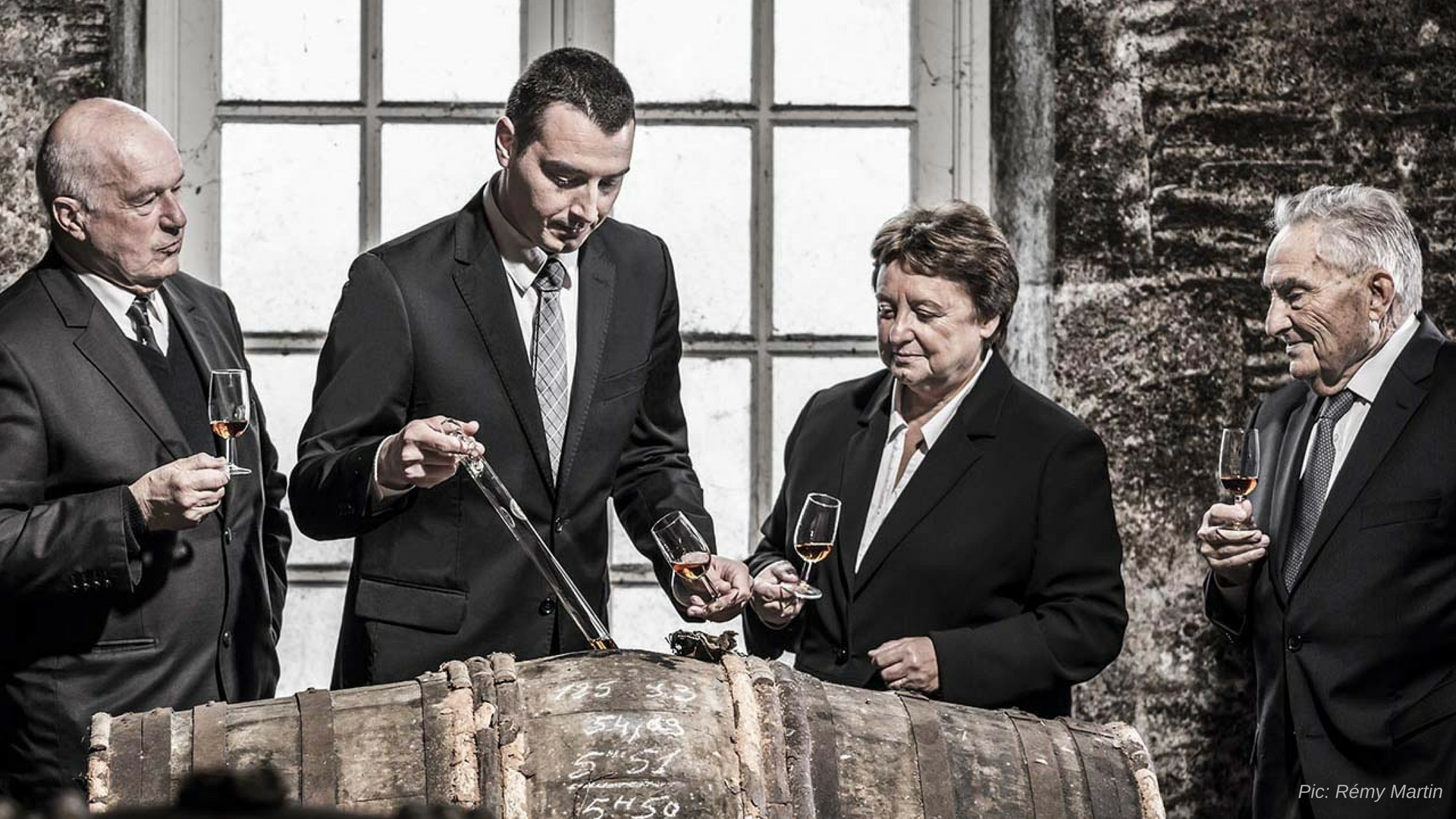
A lot is spoken about the tierçons that are used to mature Rémy Martin’s finest Eaux de Vie (EDV) and the final blend of Louis Treize. Can you elaborate on them? How different or similar are they to the regular barriques used in the region?
BL: Tierçons are a century old casks exclusive to LOUIS XIII and are a rare heritage from the past. In the days when Cognac was transported in barrels, they were the cask of choice and would be stored in threes on carts, hence their name (tierce means “a third” in French).
You are absolutely right in mentioning that we age our best EDV in these tierçons and they are candidates for the final blend of Louis Treize. Apart from that, the final blend of Louis Treize is also aged in tierçons.
Tierçons were hand made on-site in the forests of Limousin. Owing to their artisanal provenance, their size varies in the range of 520 to 580 litres depending on their shape and the length of wood pieces used. In comparison, the new oak casks we are using are 350 litres capacity.
It is a big challenge to maintain tierçons, as a leaking one implies cannibalizing from another one for repairs. Their preciousness dictates that we wait for three to four tierçons requiring repairs before actually breaking one down for the purpose. I have a team of four well skilled Coopers who do this job fantastically well.
But pending the necessary repairs a leaking tierçon must be resulting in significant loss of precious EDV?
BL: We have many cellar hands who immediately shift the EDV elsewhere at the slightest evidence of a leakage. This action is done even more urgently when the tierçon in question is containing a Grande Champagne EDV or the final blend of Louis XIII.
How much is the “angel’s share” attributable to these tierçons?
BL: Angel’s Share depends on the specific year as also the cellar environment, with the variables being humidity and temperature. In our cellars it is roughly in the range of 1.5-3%.
Do you resort to chill filtering your cognacs?
BL: It depends on the quality of the blend, it’s character and richness. We do chill filter some while not the others. Where more stability in EDV is desired, we resort to chill filtering. In other cases we would not want to damage a particular character of the EDV. These are secrets well kept (smiles).
How important are lees in ageing Cognac?
BL: They are very crucial- in fact they are an important determinant of a cognac’s style.Traditional distillation in Cognac region has always been done with lees because even 2-3 centuries ago people were aware that lees impart the best ageing potential to a cognac. The highest quality lees impart creamy, buttery, floral and soapy aromas that render a good ageing potential to a cognac. Imagine a nice Chardonnay with or without batonnage and you would probably imagine the effect of lees on a Cognac as well.
I believe that some of the EDV going into Louis XIII come from other distillers in Cognac? How do you go about ensuring quality?
BL: Ever since the house of Rémy Martin established a synergetic relationship in 1965 with local growers called the Alliance Fine Champagne, this visionary partnership has ensured that we get high quality EDV to produce our cognacs. We work closely with the winegrowers, advice them on the right time of harvesting and insist on traditional distillation methods, long and complex as they may be. Some of these distillates have the potential to be a part of the Louis XIII blend and are selected accordingly. Though we have in house knowhow to produce these fine EDV, we consider it extremely important to transmit this savoir faire and craftsmanship to other growers, who may be our technical partners at first but more importantly they are an essential part of our family. Without any doubts I can say that without these partners, there would be no Louis Treize.
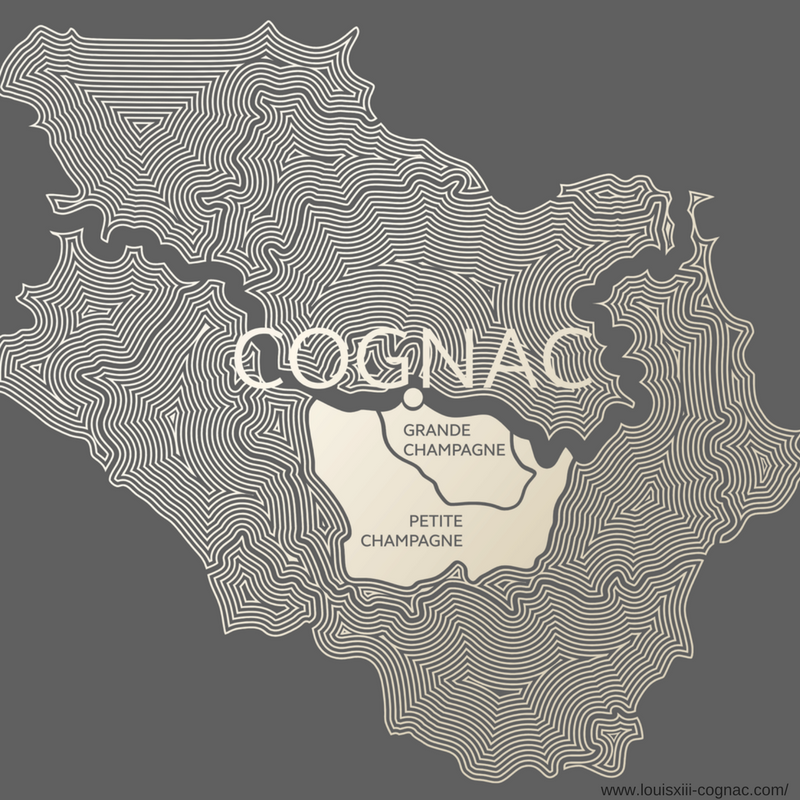
What is that one most valuable guidance that your predecessor Pierette Trichette provided apart of course transferring her knowledge to you?
BL: <Taking a deep breath> Oh la la! She told me everything- from ripeness of grapes to the final blend of Louis XIII. It was a huge apprenticeship to say in the least. But if I were to recollect the most ingrained advice from her, it would be two pieces of wisdom:
Pierrette Trichet’s most valuable advice to Baptiste Loiseau
- Never stop to be demanding. If you want the highest quality, you have to be the most demanding man of the region. To the extent that even if people label you as being extremely demanding, it is never enough.
- From time to time, you will feel that you are taking the right direction, making the right decisions but you can’t explain it in as many words. It’s not a problem Baptiste. You have to trust your feelings . That’s the magic of being behind the most wonderful Cognac in the range.
So, the combination of being demanding, being the one who would give advice, asking people to make the best effort to reach the highest quality and having courage of conviction is the key to produce a fine product such as Louis XIII. Nature is too strong and we can’t always explain what’s going on, but if with all the acquired skills and experience one feels as going in the right direction, one should trust his/her instincts.
<Baptiste starts to pour Louis Treize from the decanter but momentarily stopped by me to take a video. The bouquet of the cognac rapidly spreads in our immediate environs> .
BL: Now for the moment of revelation (smiles).
<Baptiste, Maxime and I commence the tasting>
I : It’s magnificent! The moment you started pouring it, the aromas were literally jumping out of the glass.
BL: Louis Treize is a question of time, patience and life achievement across four generations of cellar masters. So when we are selecting the EDV, we are already thinking of a century in the mind, preparing the vision for the next generation of cellar masters. The EDV that I blend every year to make Louis XIII has been selected by the previous generations. I am now part of this history, but I am here just for a few years to pass the baton to the next cellar master who will make the final blend of EDV that have been selected by his/her predecessors.
Maxime Pulci (MP): It is also interesting to note that the EDV selected by a cellar master for final blend of Louis XIII pertains to a vintage when he/she was not even born!
BL: Yes, to think so, the oldest EDV in Louis Treize blended by me is even older than the youngest EDV which is older than me. It is amazing to make that kind of a blend.
MP : What do you think when you select an EDV that relates to an important historical milestone, say-, the second world war?
BL: You often pay tribute to such EDV while blending them, but again, the focus is not on their age/era, rather on the kind of characteristics that we are looking for. If it is not that way then we would tend to preserve them for their historical significance. So what I am doing is tapping the EDV that come maybe from the period of second world war without any qualms.
Our Tasting Discussion
I: Floral, nutty and honeyed aromas are the first ones that I can notice. It evolves into a more complex bouquet which can only be analysed at leisure.
Baptiste: The woodiness of tierçons is quite expressive too.
Maxime: It is very fresh with power on the back palate. There’s a distinctive floral note to it that I am trying to recollect. Maybe a rose?
Baptiste: <validating Maxime’s thought> It is Lilac.
Maxime: Voilà!
<we continue dwelling on the cognac even as I proceed further with my questions>
Louis XIII is said to be a blend of upto 1200 EDV. How do you decide when to stop blending while assembling it?
BL: <smiling> That was Maxime’s question too around 3 hours back. In one phrase I would say that “you just feel it”. When you are tasting a blend and find something missing, you do more trials. These trials can be just adding a few more EDV or starting from a scratch altogether. We approach the blend by experimenting with small volumes. Once satisfied, the blend is compared to the previous year’s blend. If at that stage too, a difference in palate and aromas is detected, it tells us that we have not gone in the right direction and the trials continue further. Generally, I get the blend of Louis Treize right after a few trials but at times the process can take months altogether.
Every year I have to achieve this mission- to ensure the consistency of Louis Treize with the previous year’s blend as the yardstick. If I don’t do this then I know that connoisseurs and loyal clients of Louis Treize will find something amiss and might question its integrity. Hence maintaining this style is the most important aspect of my job.
That’s quite a responsibility on your shoulders.
BL:The responsibility is huge and it took me years to be trained to fulfil it. Of course I still have doubts but I work very hard on them. I hardly sleep a lot because I am always wondering about selecting EDV. Dillemas like- “if I select this EDV it will give spicy notes but that might come at the cost of floral or fruity notes”. Or wondering “is it the right time to use this EDV? Am I using it in the right percentage?” So it is always going forward and backward to arrive at a decision.
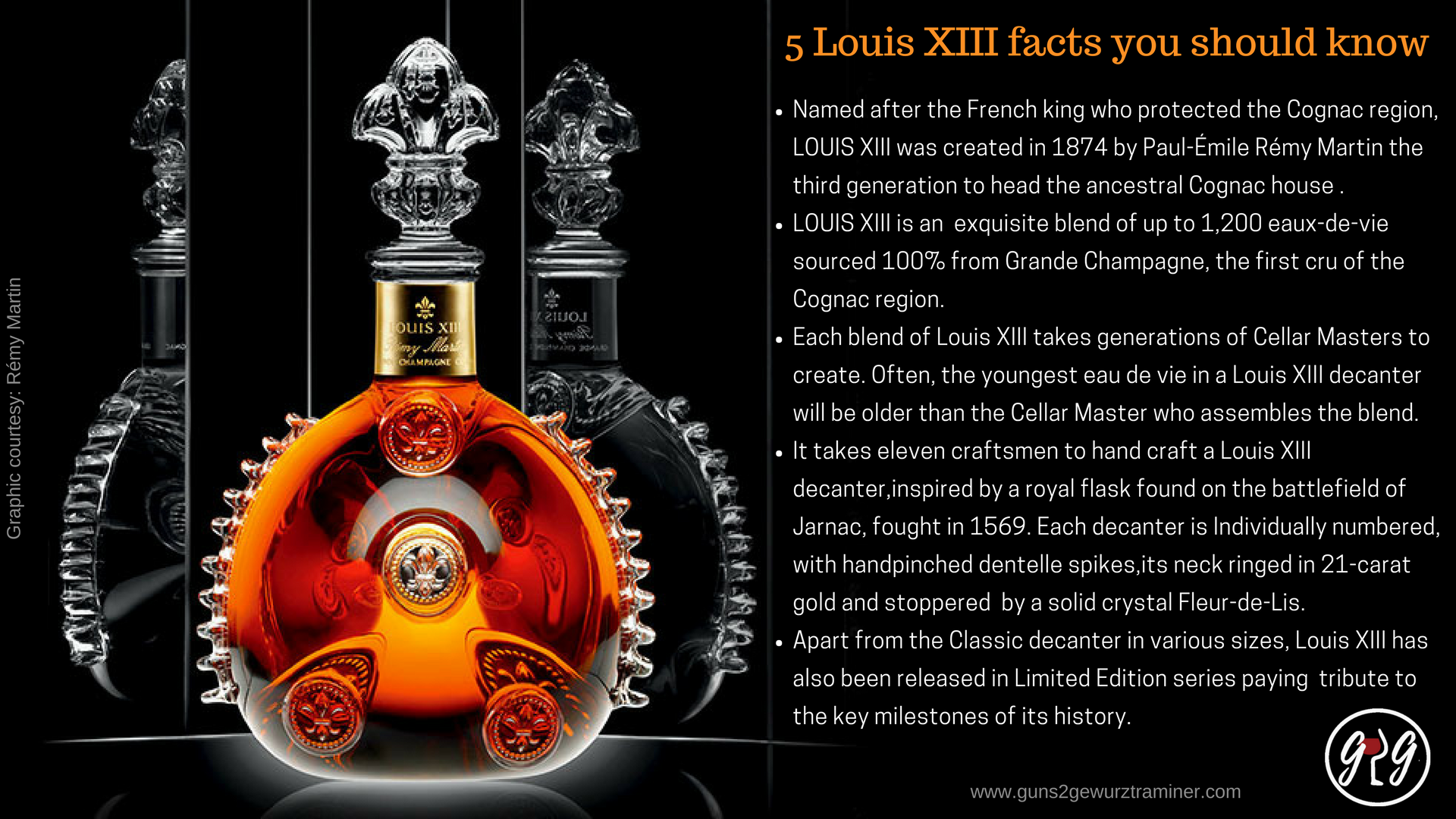
A 750 ml decanter of Louis XIII sells in retail in India at $4297 (approx INR 2,75,000)
For more information on Louis XIII, visit https://www.louisxiii-cognac.com
How do you tackle palate fatigue while tasting so many EDV?
BL: Most of the times (around 95% of the cases) we only nose the EDV since it is 70% alcohol that we are dealing with. We dilute the EDV half with water to release more aromas. So when we have more than 20-25 samples, we only nose them. After shortlisting 3-5 samples, we taste them, as more than that often saturates the palate.
In the case of of Louis XIII final blend, we taste only 2-3 samples because the very first sample itself is so long on the aftertaste that you cannot feel the second one for a long time. Hence the tasting duration must be really-really long to appreciate the facets of the product.
Do you take any special measures to protect your palate which appears to me as most critical to your trade?
BL: Only drinking cognac <smiles>. On a serious note, during winters, I take care of my nose to prevent it from cold. I also avoid spicy food at lunch if there are samples to be tasted later in the afternoon. All these measures are simple and not very restrictive.
I am however, much more sensitive to air conditioning. So when I travel, too cold rooms can really affect the sensitivity of my nose. Generally when I return back from an overseas trip, it takes a while for my nose to get back to the tasting grid.
I’m much focused on the fact that I have to keep my nose and brain curious on new flavours to be experienced. During my India visit, I experienced a Chinese preparation that was dominant with coriander. Though I don’t like coriander at all, it was an important experience for my brain and palate in the interest of recognizing these flavours in later experiences. Hence it was a valuable learning exercise.
Global climate change is said to be shifting optimum production regions of many Geographically Indicated products northwards or southwards of their well documented locations. How far is Cognac affected by such a change?
BL: It is true that change in global climate is affecting one and all. In the current day we are resorting to measures like harvesting earlier but these measures will not be sufficient in say, the next fifty years due to an accelerated affect. The problem has to be addressed collectively by all nations rather than a select few and initiatives like the Paris Climate Agreement are a welcome initiative in this respect.
Notwithstanding these efforts, we as an industry have started experimenting with newer white grapes that can retain acidity even during hot summers.These experiments will take a few more years before we can arrive at a conclusion.
However, I do not think that Cognac production region is going to shift, for the simple fact that you don’t have the same kind of soil elsewhere. What makes Grande Champagne great is the chalky soil and when we mention terroir, it’s not only about climate but the soil and the people-whom we tend to forget as a determining factor. So in Cognac we have the chalky soil, a changing climate and the people who can take measures to adapt to the climate change.
